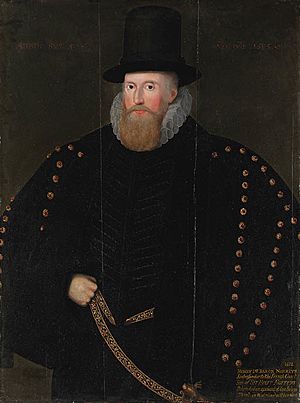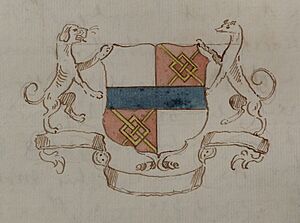Henry Norris, 1st Baron Norreys facts for kids
Quick facts for kids
Henry Norris
|
|
|---|---|
| Baron Norreys | |

Henry Norris, aged 60, 1585
|
|
| Born | c. 1525 |
| Died | 27 June 1601 (aged 75–76) Rycote |
| Buried | 5 August 1601 Chapel of St Michael and All Angels, Rycote 51°44′17″N 1°02′07″W / 51.73802°N 1.03517°W |
| Spouse(s) | Margery Williams |
| Issue | Sir John Norreys Sir William Norreys Sir Edward Norreys Catherine Norreys Sir Henry Norreys Sir Thomas Norreys Maximilian Norreys |
| Father | Henry Norris |
| Mother | Mary Fiennes, Lady Norris |
| Occupation | English politician and diplomat |
Henry Norris (also spelled Norreys), 1st Baron Norreys (born around 1525 – died 27 June 1601) was an important English politician and diplomat. He came from an old family in Berkshire, England. Many people in his family had worked for the English royal court.
Contents
Early Life and Family
Henry Norris had a difficult start to life. His mother passed away in 1531. A few years later, in 1536, his father was executed. This left Henry and his younger sister, Mary, without parents.
Their uncle, Sir John Norreys, took them in and raised them. In 1539, King Henry VIII made sure that Henry got his family's lands and wealth back. By 1542, Henry was engaged to Margery Williams. She was the daughter of a very rich man named John Williams.
Growing Up and Gaining Wealth
Henry's future looked very bright. In 1547, he became a "Knight of the Shire" for Berkshire. This meant he was a representative for the area in Parliament.
His wife, Margery, was also set to inherit a lot of money and land from her father. When Henry's uncle died in 1563 and his father-in-law died in 1559, Henry became even wealthier. He gained many properties, including Rycote in Oxfordshire, where he and Margery made their home.
Friendship with Queen Elizabeth I
In 1553, Henry was among the gentlemen who supported Lady Jane Grey as queen. However, when Queen Mary took the throne, she didn't punish him for this.
Later, in 1554, Henry was given the job of guarding Princess Elizabeth at Woodstock. Elizabeth believed that Henry's father had been loyal to her own mother, Anne Boleyn. Because of this, Elizabeth trusted Henry and his wife, Margery, very much. They remained close friends with the Queen for the rest of their lives.
Royal Visits to Rycote
Queen Elizabeth I visited Henry and Margery at their home in Rycote, Oxfordshire, many times. She visited in 1566, 1568, 1570, 1572, and again in 1592. During her visit in 1566, she even made Henry a knight.
When their son, Sir John Norreys, died, Queen Elizabeth sent a very kind letter to Margery. She affectionately called Margery "my own dear crow." John Norreys was a brave soldier who fought in Elizabeth's armies.
Later Career and Achievements
In 1561, Henry Norris became the High Sheriff for both Oxfordshire and Berkshire. This was an important local government job.
In 1566, Queen Elizabeth appointed him as the Ambassador to France. This meant he represented England in France. He served there until 1570. To thank him for his service, the Queen made him a lord. On 8 May 1572, he became Baron Norreys of Rycote and joined the House of Lords.
In 1596, Henry was also made the Lord Lieutenant of Oxfordshire. He already held the same position for Berkshire. These roles involved leading the local militia and keeping order.
Marriage and Children
Henry Norris married Margery Williams sometime between 1542 and 1544. They had seven children together. Their six sons all became famous soldiers.
- Sir John Norreys (1547–1597)
- Sir William Norreys (1548–1579), died in Ireland.
- Sir Edward Norreys (around 1550–1603), who was a governor in Ostend.
- Catherine Norreys (around 1553–), who married Sir Anthony Paulet.
- Sir Henry Norreys (1554–1599), who fought in the Netherlands and Ireland.
- Sir Thomas Norreys (1556–1599), who was a Lord President in Ireland.
- Maximilian Norreys (around 1557–1593), who was killed in Brittany while serving under his brother, John.
Queen Elizabeth cared deeply for the Norris family. When Edward, one of their sons, was serving as governor in Ostend, the Queen sent him home. This was because all of his brothers had died as soldiers, and she wanted Margery to have at least one son still alive. Margery died soon after in 1599. The Queen even forgave a large debt of £2,000 that the family owed.
Death and Burial
Henry Norris passed away on 27 June 1601. He had outlived his wife and five of his children. He was first buried temporarily in a church at Englefield. Later, on 5 August, he was reburied at Rycote. His final resting place is in a vault beneath the Chapel of St Michael and All Angels, located on the grounds of Rycote House.
Family Monument
Henry and Margery, along with their six sons, are honored by a special monument in St. Andrew's Chapel in Westminster Abbey. The monument features life-size statues of Lord and Lady Norreys lying beneath a beautiful stone canopy. Around them are kneeling figures of their children, remembering their brave lives.


